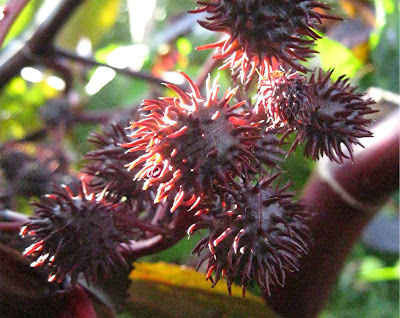
Standing inside the Capitol Columns, I'm just about 85 feet above sea level. The peak of Mt Hamilton towers over the columns by 150+ feet. It's really not nice, or even accurate to say it's less than a hill; it's a perfectly respectable hill, it's just not a mountain. The Azalea Collection lives on the south and west slopes. The west side, I faced west as I took the picture, currently exists as natural forest. A few things have been planted there over the years, but by and large it's native.
A week or so ago, Nancy Luria forwarded an article from
The National Republican on June 22, 1880. It was a rambling essay about the areas adjoining Gallaudet University. The prose is romantic, as "nature essays" were in the 1880's, florid even. I always enjoy reading historical accounts of places that I know. This did not disappoint, though it may be a stretch to call it a historic event. No one seems to know the origin of the name "Mt. Hamilton", but the article references two earlier names.
Mulligan's Hill, name for "...an old hermit of that name, who retired to it's picturesque seclusion about the time of the Bladensburg races..." "Bladensburg races" here refers to the infamous Battle of Bladensburg (1814) where a force of British infantry overwhelmed a somewhat larger, if ragged, force of US militiamen, routed them, entered the city, and burned the Capitol. The implication is that the hermit was one of the thousands of militiamen that broke and ran through the streets of Washington, and his shame drove him to sequester himself on the ferny slopes of Mt. Hamilton. At some point during the ensuing 66 years the name changed to "Fern Hill". Also the title of one of my favorite poems. No matter. And somehow it became Mt. Hamilton. Lynn Batdorf, one of two unofficial Arboretum historians, assures me this is not a reference to Alexander Hamilton, who, died after being mortally wounded by Aaron Burr in a duel at the Bladensburg Dueling grounds. It's a small world.
The essay continues rhapsodizing botanically and touches on a couple of interesting plants:
Magnolia virginiana, the Sweetbay, and
Epigaea repens, Trailing Arbutus. "The graceful and odoriferous magnolia has its favorite home in the marshes of the Anacostia east of Kendall Green..." We do indeed still have the remnants of a Magnolia Bog near the Anacostia River at the NE corner of the Arboretum. "In these woods the trailing arbutus is found in profusion, almost the only place about Washington where it can be had without toil and search" Trailing Arbutus still exists in a handful of sites on the slopes of Mt Hamilton 131 years later.



 From the Top: a view across Beechspring Pond; Fern Valley looking down the main trail; Fern Valley the view along Crabtree Road; China Valley near the entrance
From the Top: a view across Beechspring Pond; Fern Valley looking down the main trail; Fern Valley the view along Crabtree Road; China Valley near the entrance












